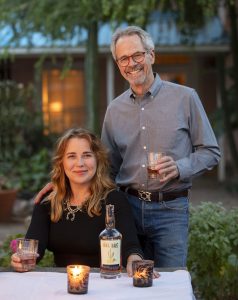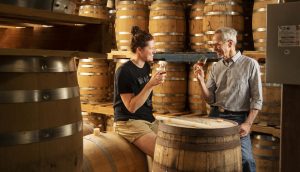By Richard Thomas
One of the more interesting features of the American craft whiskey boom is the regional spins it has put on what had been, during the second half of the 20th Century at any rate, an industry of the Upper South. When this 21st Century phenomenon brought commercial whiskey-making to the Southwest for the first time, it incorporated local ingredients–especially mesquite–and adapted to make the best use of the desert climate.
Hamilton Distillers was one of the earliest entrants into the Southwest’s burgeoning craft whiskey picture, so much so that the distillery is an example of how a craft distiller’s brands can evolve over time (a project The Whiskey Reviewer will be catching up with directly). I had an opportunity to go over it all with Stephen Paul, co-founder and president at Hamilton Distillers.
RT: My understanding is that the idea for Whiskey del Bac came out of a conversation you were having one night with your wife, when she posed the question of smoking malted barley with mesquite instead of peat. You then picked up a small Portuguese still — a Hoga, right? — and began experimenting. Do you have any fun stories about those early experiments?
SP: I first got a 5 gallon alembic from Portugal. [It] wasn’t a Hoga, don’t remember the company, and used home-brewing sized equipment to brew with. Tried using turbo yeast in the little 5 gal fermenting buckets, fermenting in our laundry room off the kitchen. In one batch I pitched too much yeast and the top blew off the bucket, clear up to the ceiling, scattering beer and krausen all over the room and its contents. So I and my project got kicked out of the laundry room. My wife was somewhat tolerant of the project but very skeptical of the safety aspect, and really didn’t like the equipment sitting around. (After a long career as an attorney she became a very successful interior designer.) Another time while distilling on the little still I heated it up too fast and blew the top off, turning my face away in time but scalding my ear and my chest through my shirt. This was something I couldn’t let her know about or we wouldn’t have a distillery today. The ear and the chest blistered up and then bled after a couple of days, and I could not go shirtless for a couple of months or I’d have had to answer some tough questions. I was just able to cover the ear enough to go undetected there.
RT: You began experimenting in 2006, and you had your initial releases in 2013. My understanding is you bought new distillery equipment, including a much larger still, the very next year. Also, you yourself told me your whiskey had evolved since my own exposure several years ago. So, how have things changed and how has that played out on your whiskey-making?
SP: I actually graduated to a 40 gallon still in 2011 [from the] same Portuguese company. I set up that still in a partitioned off area in the wood shop. My daughter, by that time, had moved back to Tucson after 10 years in NY, and insisted I get legal, since we would always give tours of the shop because we were doing a lot of interesting things in furniture building that had fallen by the wayside in modern woodworking, like dovetail and mortise-and-tenon joinery, and the mesquite aspect was very different than dealing with standard hardwoods for many reasons, and also we had our own kiln to dry the wood because you couldn’t get dry mesquite.
We actually guaranteed our furniture on-going, so we had to make sure the wood was dry! Long story there – I’ll spare you.
We took Del Bac to the local Tucson marketplace off that 40 gal still in late ’13 and it was warmly recieved. Got investment to implement the 500 gal system with a 5,000 lb malt house in ’14, became operational on that system in late “14. The whiskey was improving on the 40 gal still, and I was learning how to malt. The first batches of Dorado were very smoky, and I wasn’t thrilled with it even though people liked it well enough. So twice during ’15 and early ’16 I backed off the smoke, to where now we’re really happy with the balance of the mesquite and the underlying flavor nuance.
RT: I know you aren’t the oldest working distillery in Arizona, but I gather you got started before most of the current crop came along. What your outlook on how the state’s craft distilling sector has grown up?
SP: We were #2 in the state, after Desert Diamond in Kingman. Now there are at least 14. We have a guild that is pretty active, and as it is around the country, awareness of craft distilling is elevated. I’m not sure what the numbers for the other distilleries are, but we sold about 2,400 cases in Arizona in 2019, and feel there is a ton of room to grow. We should be able to sell 10,000 cases in Arizona if not more.
RT: It’s the obvious question this year: how are you doing during the pandemic?
SP: We’re actually doing well. We had expected our sales to go down much more. It turns out that we have a lot more off-premise accounts than most craft distillers, including some big accounts in Arizona like Total Wine, Costco, Safeway/Albertson’s, Trader Joe’s and some Whole Foods. We’re not as dependent on bar/restaurant accounts as some other distilleries.
RT: Arizona is so much different from the traditional whiskey heartland of the Upper South and Mid-Atlantic. Many of the new wave of distillers embraces their local climates to put a distinctive twist on their maturation, and I’d like to hear about the barrel stock you’ve chosen and how you’ve harnessed (or chosen not to harness) the Sonoran Desert to mature your whiskey.
SP: We totally embrace what our extreme climate here gives us. Our high summer heat accelerates maturation, as does our radical diurnal shift, which can delta to 40 degrees in a day, activating the dynamic between the wood and the whiskey in the barrel. Our very low humidity increases our evaporation loss, and I chose The Barrel Mill as our cooperage partly because their staves are 1/8″ thicker than others.
Other things besides climate contributing to our regionality that are desert-related are the minerality in our water and of course our use of this desert wood to dry the malt.
RT: So, who has made the best cocktail thus far with your Dorado Whiskey?
SP: We have so many loyal bartenders. I hesitate to single out someone in particular. I will say that some of the work done with our Southwestern ingredients has been really cool. Prickly pear syrup, tincture of creosote bush, mesquite bean syrup, mole bitters, etc.
 The Whiskey Reviewer A World of Whiskey, Poured Every Weekday
The Whiskey Reviewer A World of Whiskey, Poured Every Weekday


